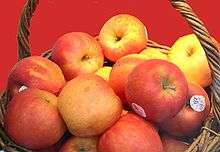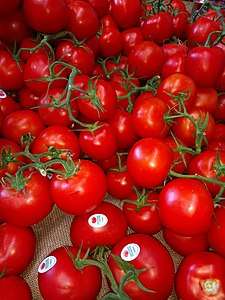Price look-up code
Price look-up codes, commonly called PLU codes, PLU numbers, PLUs, produce codes, or produce labels, are a system of numbers that uniquely identify bulk produce sold in grocery stores and supermarkets. The codes have been in use since 1990, and over 1400 have been assigned.[1] The codes are administered by the International Federation for Produce Standards (IFPS), a global coalition of fruit and vegetable associations that was formed in 2001 to introduce PLU numbers globally.[2]

Produce labeled with PLU codes eliminates the need for grocery store checkers and customers to visually identify different varieties, which can make check-out and inventory control easier, faster, and more accurate – something that is important when varieties of produce look similar but have different prices, such as organic and conventional (non-organic) varieties.
Uses
PLU codes are used primarily in retail grocery stores or supermarkets, where they are keyed into point of sale systems by cashiers or by customers at self checkout machines when the produce is being weighed or counted. The codes may be printed on small stickers, tags, or bands that are affixed to produce, or may be printed on signs. Since 2006, stickers with PLU codes may also have a GS1 DataBar Stacked Omnidirectional barcode.[3]
Numbering conventions

Non-organic produce is randomly assigned four-digit PLU codes in the 3000 and 4000 series.[1] Organic produce may be designated by prefixing the four-digit, non-organic PLU with a "9". For example, non-organic bananas are 4011, while organic bananas are 94011.
In the future, the 83000 and 84000 series will be used; however, unlike the "9" prefix, the leading "8" will not denote a general category. (At one time, numbers prefixed with "8" were reserved for GMO products, but they were opened for general use after GMO growers didn't use them.)[4]
Retailer-assigned codes
Some PLU code ranges are reserved for retailers. This allows codes to be defined by individual retailers or location, and allows the use of PLU codes in lieu of barcodes. There are retailer-assigned ranges for general and category-specific use. For example, 3170–3269 can be assigned by retailers to any goods, while 4193–4217 can only be assigned to apples.
Suppliers may coordinate with their retailers to use the same code in the retailer-assigned range for a specific product.
Promotion via PLU stickers
Some producers have obtained a licence to place characters on stickers on PLU code labels, often as a promotion for a movie, television show or other media franchise. For example, Imagination Farms has marketed produce with collectible Disney character stickers such as Toy Story and Finding Nemo under the Disney Garden brand[5], and Chiquita has marketed bananas with Minions stickers on them, along with a competition.[6]
Collecting
Although the collecting of PLU labels as a hobby already existed for a while, it became widespread through social media presence and fashion designs that use fruit stickers. The popularity of the hobby was further increased by online catalogs and collector clubs.[7]
In addition to illustrations, important factors for collectors are compositions of these stickers and the type of product they are used on. Most popular materials for creating PLU code stickers are plastic film and paper, however cardboard, metallized film, wrapping tissue, and textiles are also known to be used.
See also
- Universal Product Code, another system for identification of consumer products
- Stock-keeping unit (SKU) codes, another system
- Packaging and labeling
References
- "PLU Codes Frequently Asked Questions" (PDF). IFPS. Retrieved 24 September 2015.
- "About IFPS: Who are we?". IFPS. Archived from the original on 10 March 2015. Retrieved 24 September 2015.
IFPS is composed of national produce associations from around the globe.
- "GS1 DataBar". Retrieved 8 August 2015.
- "IFPS Media Release: PLU code transition" (PDF). IFPS. Retrieved 20 January 2016.
- Imagination Farms announces Disney branding effort. The Packer. 17 May 2011
- Heather Fletcher. Case Study: Minions, Is That a Banana in Your Pocket?, Target Marketing, October 1, 2015
- "Fruit Stickers on Colnect". colnect.com. Retrieved 2018-12-27.
External links
- The International Federation for Produce Standards (IFPS) website
- User Guides (international Price Look-Up numbering scheme) http://www.ifpsglobal.com/Portals/22/IFPS%20Documents/PLU%20User%20guides/PLU%20Users%20Guide_Aug%202015.pdf
- A complete list of all currently assigned PLU numbers: http://www.ifpsglobal.com/Identification/PLU-Codes/PLU-codes-Search
- Online collection of PLU labels: http://www.fruitsticker.de
- PLU Lookup Utility: http://bobbywires.com/plu-1.php